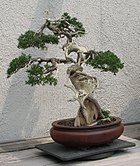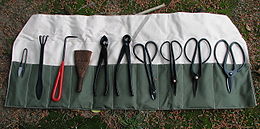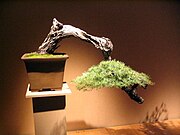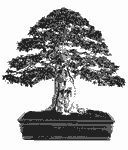Bonsai listen (help·info) (Japanese: 盆栽, Chinese: 盆栽, literally "potted plant") is the art of aesthetic miniaturization of trees by growing them in containers. Cultivation includes techniques for shaping, watering, and repotting in various styles of containers.
Originating in China during the Han Dynasty, 'bonsai' is a Japanese pronunciation of the Chinese word penzai (盆栽). The word bonsai is used in the West as an umbrella term for all miniature trees in containers or pots.
History
The origins of bonsai are believed to have begun at least 4000 years ago during the Han Dynasty in China.[citation needed] It has since developed into new forms in parts of China, Japan, Korea and Vietnam.
At first, the Japanese used miniaturized trees grown in containers to decorate their homes and gardens.[2] During the Tokugawa period, landscape gardening attained new importance. Cultivation of plants such as azalea and maples became a pastime of the wealthy. Growing dwarf plants in containers was also popular. At this time, the term for dwarf potted trees was "a tree in a pot" (鉢の木, hachi-no-ki?).
The c.1300 rhymed prose essay, Rhymeprose on a Miniature Landscape Garden, by the Japanese Zen monk Kokan Shiren, outlines the aesthetic principles for bonsai, bonseki and garden architecture itself.
The oldest known living bonsai trees are in the collection at Happo-en (a private garden and exclusive restaurant) in Tokyo, Japan, where bonsai are between 400 to 800 years old.[citation needed]
Cultivation
Bonsai are not genetically dwarfed plants. They can be created from nearly any tree or shrub species and remain small through pot confinement with crown and root pruning. Some
specific species are more sought after for use as bonsai material, because they have characteristics that make them appropriate for the smaller design arrangements of bonsai.
Techniques

This juniper makes extensive use of both jin (deadwood branches) and shari (trunk deadwood)
The small size of the tree and the dwarfing of foliage result from pruning of both the leaves and the roots. Most trees require a dormancy period and do not grow roots or leaves at that time. Improper pruning can weaken or kill trees.[3]
Copper or aluminium wire wrapped around branches and trunks holds the branches in place until they lignify (convert into wood), usually 6-9 months or one growing season. Some species do not lignify strongly, or are already too stiff/brittle to be shaped and are not conducive to wiring, in which case shaping is accomplished primarily through pruning.[3]
Cultivators use Deadwood Bonsai Techniques called jin and shari to simulate age and maturity in a bonsai. Jin is the term used when the bark from an entire branch is removed to create the impression of a snag of deadwood. Shari denotes stripping bark from areas of the trunk to simulate natural scarring from a broken limb or lightning strike.
Watering
With limited space in a bonsai pot, regular attention is needed to ensure the tree is correctly watered. Sun, heat and wind exposure can dry bonsai trees to the point of drought in a short period of time. While some species can handle periods of relative dryness, others require near-constant moisture. Watering too frequently, or allowing the soil to remain soggy, promotes fungal infections and root rot. Free draining soil is used to prevent waterlogging. Deciduous trees are more at risk of dehydration and will wilt as the soil dries out. Evergreen trees, which tend to cope with dry conditions better, do not display signs of the problem until after damage has occurred.
Repotting

An uprooted bonsai, ready for repotting
Bonsai are repotted and root-pruned at intervals dictated by the vigour and age of each tree. In the case of deciduous trees, this is done as the tree is leaving its dormant period, generally around springtime. Bonsai are often repotted while in development, and less often as they become more mature. This prevents them from becoming pot-bound and encourages the growth of new feeder roots, allowing the tree to absorb moisture more efficiently.
Pre-bonsai material are often placed in "growing boxes" which are made from scraps of fenceboard or wood slats. These large boxes allow the roots to grow more freely and increase the vigor of the tree. The second stage, after using a grow box, has been to replant the tree in a "training box;" this is often smaller and helps to create a smaller dense root mass which can be more easily moved into a final presentation pot.
Wiring
Most bonsai are trained using malleable wire made from copper or copper colored aluminium. This is wrapped around the developing branches and trunk, allowing them to be moved into the desired shape and held in place by the wire. The tree is wired for at least one growing season to allow the branches to set in their new position. Some trees do not respond well to wiring and are shaped instead by pruning.
Tools

Set of bonsai tools (
left to right): leaf trimmer; rake with spatula; root hook;
coir brush; concave cutter; knob cutter; wire cutter; small, medium and large shears
Special tools are available for the maintenance of bonsai. The most common tool is the concave cutter (5th from left in picture), a tool designed to prune flush, without leaving a stub. Other tools include branch bending jacks, wire pliers and shears of different proportions for performing detail and rough shaping.
Soil and fertilization
Opinions about soil mixes and fertilization vary widely among practitioners. Some promote the use of organic fertilizers to augment an essentially inorganic soil mix, while others will use chemical fertilizers freely. Bonsai soil is primarily a loose, fast-draining mix of components,[4] often a base mixture of coarse sand or gravel, fired clay pellets or expanded shale combined with an organic component such as peat or bark. In Japan, volcanic soils based on clay are preferred, such as akadama, or "red ball" soil, and kanuma, a type of yellow pumice used for azaleas and other calcifuges.
Location and overwintering
Most traditional bonsai are temperate climate trees and are kept outside all year. They require full sun in summer and usually a near-freezing dormancy period in winter. Depending on how hardy the tree species is, protection from very low temperatures may be required. Certain tropical species can survive winter without a dormancy period, and can therefore be kept indoors all year.
Containers
Bonsai pots have drainage holes typically covered with a plastic screen or mesh to prevent soil from escaping.
Containers come in a variety of shapes and colors and can be glazed or unglazed. Containers with straight sides and sharp corners are generally better suited to formally presented plants, while oval or round containers might be used for plants with informal shapes. Most evergreen bonsai are placed in unglazed pots, while deciduous trees are planted in glazed pots. It is important in design that the color of the pot compliments the tree. Some pots are highly collectible, such as ancient Chinese or Japanese pots made in regions with experienced pot makers such as Tokoname, Japan or Yixing, China. Today many western potters throughout Europe and the United States produce fine quality pots for Bonsai.
Common styles

Formal upright style baldcypress

Informal upright style juniper

Root-over-rock style maple on display at at the Chinese
Penjing Collection of National Bonsai & Penjing Museum, Washington
In English, the most common styles include: formal upright, slant, informal upright, cascade, semi-cascade, raft, literati, and group/forest.
- The formal upright style, or Chokkan, is characterized by a straight, upright, tapering trunk. The trunk and branches of the informal upright style, or Moyogi, may incorporate pronounced bends and curves, but the apex of the informal upright is always located directly over where the trunk begins at the soil line.
- Slant-style, or Shakan, bonsai possess straight trunks like those of bonsai grown in the formal upright style. However, the slant style trunk emerges from the soil at an angle, and the apex of the bonsai will be located to the left or right of the root base.
- Cascade-style, or Kengai, bonsai are modeled after trees which grow over water or on the sides of mountains. The apex, or tip of the tree in the Semi-cascade-style, or Han Kengai, bonsai extend just at or beneath the lip of the bonsai pot; the apex of a (full) cascade style falls below the base of the pot.
- Raft-style, or Netsuranari, bonsai mimic a natural phenomenon that occurs when a tree topples onto its side (typically due to erosion or another natural force) and branches along the exposed side of the trunk, growing as if they are a group of new trunks. Sometimes, roots will develop from buried portions of the trunk. Raft-style bonsai can have sinuous, straight-line, or slanting trunks, all giving the illusion that they are a group of separate trees -- while actually being the branches of a tree planted on its side.
- The literati style, or Bunjin-gi, bonsai is characterized by a generally bare trunk line, with branches reduced to a minimum, and typically placed higher up on a long, often contorted trunk. This style derives its name from the Chinese literati, who were often artists, and some of whom painted Chinese brush paintings, like those found in the ancient text, The Mustard Seed Garden Manual of Painting, depicting pine trees that grew in harsh climates, struggling to reach sunlight. In Japan, the literati style is known as bunjin-gi (文人木, bunjin-gi?). (Bunjin is a translation of the Chinese phrase wenren meaning "scholars practiced in the arts" and gi is a derivative of the Japanese word, ki, for "tree").
- The group or forest style, or Yose Ue, comprises a planting of more than one tree (typically an odd number if there are three or more trees, and essentially never 4 because of its significance in Japan) in a bonsai pot. The trees are usually the same species, with a variety of heights employed to add visual interest and to reflect the age differences encountered in mature forests.
- The root-over-rock style, or Sekijoju, is a style in which the roots of a tree (typically a fig tree) are wrapped around a rock. The rock is at the base of the trunk, with the roots exposed to varying degrees.
- The broom style, or Hokidachi is employed for trees with extensive, fine branching, often with species like elms. The trunk is straight and upright. It branches out in all directions about 1/3 of the way up the entire height of the tree. The branches and leaves form a ball-shaped crown which can also be very beautiful during the winter months.
- The multi-trunk style, or Ikadabuki has all the trunks growing out of one root system, and it actually is one single tree. All the trunks form one crown of leaves, in which the thickest and most developed trunk forms the top.
- The growing-in-a-rock, or Ishizuke style means the roots of the tree are growing in the cracks and holes of the rock. There is not much room for the roots to develop and take up nutrients. These trees are designed to visually represent that the tree has to struggle to survive.
 Water gardens are one of the most attractive kinds of gardens. Aside from the plants around it, the fishes swimming around a water gardens pond makes it lively and unique.
Water gardens are one of the most attractive kinds of gardens. Aside from the plants around it, the fishes swimming around a water gardens pond makes it lively and unique.
 An inside bonsai tree is going to be a great looking creature. They are going to be formal plants that sit up and are going to be different from anything else that you have ever seen.
An inside bonsai tree is going to be a great looking creature. They are going to be formal plants that sit up and are going to be different from anything else that you have ever seen. Through the use of prune techniques, it is possible to shape your tree to certain style. There are seven main tree shapes that all have their own benefits for certain situations.
Through the use of prune techniques, it is possible to shape your tree to certain style. There are seven main tree shapes that all have their own benefits for certain situations. What would it be like to have a garden with flora highly perfumed for flowers? I can almost see smiling faces and nodding heads of those who already have magnolia plants on their gardens.
What would it be like to have a garden with flora highly perfumed for flowers? I can almost see smiling faces and nodding heads of those who already have magnolia plants on their gardens. Houseplants and herb gardens are well-known as common plants that are grown indoors. But they are not the only plants that can be grown indoors.
Houseplants and herb gardens are well-known as common plants that are grown indoors. But they are not the only plants that can be grown indoors. Whether planning to start your own garden, or simply looking for a little extra advice, gardening is such a popular hobby these days that there are many methods and means of help available to assist you.
Whether planning to start your own garden, or simply looking for a little extra advice, gardening is such a popular hobby these days that there are many methods and means of help available to assist you. There is a great of large bonsai tree in the world public places…. When you hear bonsai, in your mind you will imagine a beautiful miniature tree, artistically bent and grown adorning a centre table somewhere. Bonsai, indeed, means tiny trees and what you think about it is not wrong.
There is a great of large bonsai tree in the world public places…. When you hear bonsai, in your mind you will imagine a beautiful miniature tree, artistically bent and grown adorning a centre table somewhere. Bonsai, indeed, means tiny trees and what you think about it is not wrong.













 This is picture of Adenium Arabicum: Ra Chi Nee Pan Dok (RCN). It is hybrid of Thai Arabicums. It's also call "Queen of 1,000 flowers" because it's have many flowers and can bloom out not only from branches but from stems too
This is picture of Adenium Arabicum: Ra Chi Nee Pan Dok (RCN). It is hybrid of Thai Arabicums. It's also call "Queen of 1,000 flowers" because it's have many flowers and can bloom out not only from branches but from stems too if you have good picture and want to share, pls leave comment
if you have good picture and want to share, pls leave comment

















